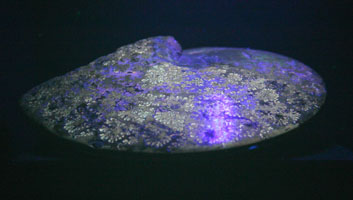The Placenticeras genus is characterized by a tightly coiled (moderately involute umbilicus), lenticular (lens shaped), shell. The umbilicus (center) is well rounded and moderately deep. The flanks (sides) are broad, convex and ornamented, in some species, with ribs and tubercles along the umbilicus and midflank. The keel or venter (outside edge) is narrow and flat to slightly concave and protects the siphuncle. The siphuncle is the tube which connects the chambers allowing the animal to fill them with water or air to rise and lower in the water. Placenticeras has a very complex suture pattern with 10 to 14 divided, deep, narrow-necked saddles, lobes, and sinuses.
Placenticeras meeki is distinquished by its smooth convex, broad, nearly unornamented flanks, and smooth venter. Some Placenticeras meeki specimens occasionally possess small tubercles along the umbilical shoulder and some slight, broad, low ribbing. Placenticeras meeki can range up to nearly 32 inches in diameter.
Placenticeras: Placenta - means flat cake, ceras - means horn.
You see ammonites in books with these unusual alternating chamber colors, but seldom do you see one offered for sale. The top portion of the shell was crushed at some point. If you will notice at the top is a small Placenticeras specimen which has not been fully exposed. With a little additional work this could be made into a very nice piece.
Many of the ammonites from South Dakota will fluoresce due to the replacement of the shell by calcite and chalcedony. The calcite will fluoresce from white to yellow to orange. The chalcedony usually shows up as a green fluorescence. Usually the stronger fluorescence is under long wave and is the first photo shown in the fluorescents (South Dakota) section of the web site. Chalcedony usually does not fluoresce well under long wave, but does fairly well for the fossils from this area.
The first photo of this specimen was taken under long wave fluorescent light. You can see by the by the fluorescence under both long and short wave that the replacement minerals are calcite and chalcedony. Also check out other South Dakota fluorescent offerings under the Fluorescents section. Then click on the "To view specimen material from South Dakota" link. Some other normal light photos will be shown there as well.
To see photos of this specimen under normal lighting, go to the ammonite section under fossils, specimen number FA-222.
Placenticeras meeki 
Quantity in Basket: None
Code: FA-222F
Price: $675.00
Shipping Weight: 3.79 pounds
Time: Upper Cretaceous, Upper Campian, approximately 74-72 million years ago.
Location: Pierre Shale, South Dakota
Dimensions: 8-1/2 inches